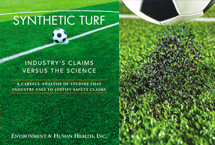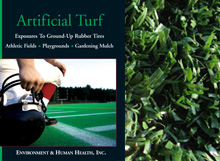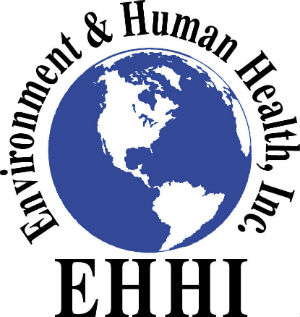EHHI's report on artificial turf calls attention to growing concerns about children’s
exposures to ground-up rubber tires used as infill material in synthetic turf fields. Crumb rubber is used in artificial turf and as playground mulch, despite potential health hazards, especially under high temperatures.
Natural grass fields get a few degrees hotter than the outside air, but synthetic turf fields get 60 to 70 degrees hotter than the outside air. This excess heat makes these fields potentially very dangerous. Athletes can get dehydrated and even suffer heat stroke while playing on them. Small children are even at a higher risk.
The chemical analysis conducted at Yale University (see below) found 10 carcinogens in the synthetic turf tested. High temperatures cause crumb rubber infill to outgas at a higher rate, which also poses an additional health risk to those who play on these fields in the summer.
In 2009, University of Washington assistant soccer coach Amy Griffin noticed abnormally high rates of cancer in athletes who played on synthetic turf. As of April 2016, she had counted 220 athletes with cancer. Of the 166 soccer players with cancer, 102 of them, or 61%, were goalkeepers. The only athletes in this informal count were those who knew to call Amy Griffin. There is still no government agency tracking cancers among athletes who have played on synthetic turf.
There were 96 chemicals found in 14 samples analyzed, half of which have had no government
testing.
Metal analysis conducted at Yale University on synthetic turf crumb rubber infill and playground rubber mulch.
The metal analysis conducted at Yale University shows that metals are present in crumb rubber.
Human Health Risk Assessment of Artificial Turf Fields Based Upon Results from Five Fields in Connecticut.
Because the synthetic turf industry has claimed that the CT Department of Health study shows that synthetic turf fields were safe, Environment and Human Health, Inc., felt it important to closely analyze the actual study to see what it really said. The study only looked at the health risks to those 12 years and up—yet many younger children also play on these fields. On careful reading, you will see the flaws in the study and all their stated limitations. It is hard to believe that the researchers could declare that their data showed the fields were safe.
Read EHHI's analysis here.
The European Union Ban on Microplastics Includes Artificial Turf
The European Union (EU) banned the sale of products containing intentionally added microplastics in September 2023. The regulation specifically includes crumb rubber infill used in artificial turf fields, which contribute to microplastics in the environment. The EU also urged other nations to follow suit in banning crumb rubber infill derived from shredded end-of-life automobile tires.
Report urges ban on crumb rubber infill on football pitches across Scotland
The report says a “tougher precautionary and prevention strategy” is “essential to protect users of all ages, the public, and workers who make, maintain and dispose of the crumb.”
Turf fields may have ‘forever chemicals.’ Should kids be playing on them?
Some scientists and turf critics who say the presence of PFAS in turf is worrisome, given what is already known about the toxic effects of the chemicals.
Natural grass or synthetic turf field?
This article shows that people are beginning to understand the dangers of synthetic turf fields—but it also shows our job is not finished yet. There is no safer surface for students and athletes to play on than regular grass fields.
Does playing soccer on artificial turf increase cancer risk, especially in kids?
Longtime University of Washington coach Amy Griffin has compiled a list of former goalies and other athletes with cancer who played on synthetic turf. The list now includes close to 300 people, more than half of whom have a form of blood cancer. EHHI board member David Brown discusses the toxicology of crumb rubber.
Forever Fields: Pennsylvania became a dumping ground for discarded artificial turf
Artificial turf made from scrap tires contains toxic "forever" chemicals, or PFAS. In 2018, Re-Match, a Denmark-based recycling company, paid Pennsylvania farmers to store the turf, but never built its planned recycling plant. “They call PFAS chemicals forever chemicals for a reason,” says former EPA official Kyla Bennett. “These are forever fields.”
New carcinogens discovered in rubber granulates
Researchers at the University of Amsterdam warned in January 2021 that 46 new substances have been found in crumb rubber, several of which are carcinogenic or hazardous to health. One such substance is Bisphenol F, which is very similar to Bisphenol A. Several of these newly identified substances are even more prone to leaking than other compounds in crumb rubber that are already known to be harmful. They pose risks to health, especially if they come into contact with skin, as frequently happens when sports are played on artificial turf.
Journal Article - method used to identify and quantitate PFAS, in artificial turf fiber and crumb rubber infill samples.
Extraction method with subsequent GC-MS analysis proved useful in detecting FTOHs in artificial turf field samples. 8:2 FTOH may be present in artificial turf fibers and crumb rubber infill.
Turf War: South Florida Cities Spend Millions for Fake Grass Despite Resident Outcry
Municipalities are spending big money on fake grass over the objection of residents who prefer their parks stay natural.
Opinion: Wilbur Cross High School should invest in a first-rate grass field — not a synthetic field
EHHI President Nancy Alderman asks why towns are still proposing synthetic turf fields. New Haven's Wilbur Cross High School is contemplating pulling up their grass field and putting down a synthetic turf field. With so many studies on the dangers of synthetic turf fields and professional athletes hating to play on them — why are towns still proposing them? There is no safer surface for athletes to play on than natural grass.
Boston bans artificial turf in parks due to toxic PFAS (Forever Chemicals)
Boston’s mayor has ordered no new artificial turf to be installed in city parks, making Boston the largest municipality in the nation to limit use of the product because it contains dangerous chemicals. All artificial turf is made with toxic PFAS compounds and some is still produced with ground-up tires that can contain heavy metals, benzene, VOCs and other carcinogens that can present a health threat. Dutch court convicts sports field managers for pollution with crumb rubber infill
The court ruled on a pioneering lawsuit that will have far-reaching consequences for the nearly 2000 artificial turf fields in the Netherlands currently filled with crumb rubber. Furthermore, the Dutch court ruling can inspire similar cases in countries confronted with crumb rubber infill on sports fields, such as Belgium, France, Germany, Austria, Switzerland, Norway and Denmark..
Toxic Chemicals in 13,000 Artificial Turf Fields in the U.S.
Artificial turf pellets have been shown to contain benzene, cadmium, and other known carcinogens. New tests show turf contains elevated levels of per- and polyfluoroalkyl chemicals known as PFAS, which have been linked to kidney cancer, low infant birth weights, and a range of diseases.
PFAS and PFOS Found in Abandoned Synthetic Turf
The so-called "forever chemicals"—PFAS (perfluoroalkyl and polyfluoroalkyl substances)—leach into streams. Tons of turf are taken to landfills capable of handling hazardous waste.
Toxic PFAS Chemicals Found in Artificial Turf
Laboratory testing found PFAS chemicals in the plastic backing of two samples of the turf. Analysis of the “blades” of the artificial grass showed significant levels of fluorine, which indicate the presence of cancer-causing PFAS chemicals.
Massive Federal Report Is Only First Step In Assessing Safety Of Crumb-Rubber Turf Fields
The first 800 pages of the report, issued by the U.S. Environmental Protection Agency (EPA) and the Agency for Toxics Substances and Disease Registry (ATSDR), identified a range of chemicals in crumb rubber, including metals and dozens of volatile organic compounds (VOCs) and semivolatile organic compounds (SVOCs) at low levels. Part 2 will detail risks associated with such exposures.
There Is No Safer Playing Field for Student Athletes than Grass
The OpEd by EHHI President Nancy Alderman, published in The New Haven Register, says grass is known to be safe.
Connecticut has 118 children's playgrounds surfaced with waste tires, and it's time to test them.
The OpEd by EHHI President Nancy Alderman notes that Washington, D.C., found hazardous lead in poured-in-place playgrounds.
"Artificial Turf: A Consumer Guide to Keeping Your Child Safe"
Summer is here and the temperatures are rising! Did you know that artificial turf can get up to 55°F higher than grass, and has been recorded as high as 200°F on a summer day? Scientists at Mt. Sinai's Children's Environmental Health Center recommend ways to keep you and your family safe.
"Pelletgate" holds up Pittsburgh Steelers-Buffalo Bills game
The game was delayed for around seven minutes, and was quickly dubbed "pelletgate" on social media. Batavia Turf Instant Lawns owner Craig Yunker says artificial fields produce hazardous waste, and the incident raised concerns about player safety.
Government Studying Tire Crumbs in Synthetic Turf Fields
Recycled scrap tires are used on fields and playgrounds where children play. The research is being conducted by the US Environmental Protection Agency (EPA) and the Centers for Disease Control and Prevention, the US Consumer Product Safety Commission and other agencies.
How the Synthetic Turf Industry is Bypassing Children's Safety
EHHI President Nancy Alderman's OpEd Published in The Hill
Amsterdam Says No to Rubber Granules in Artificial Turf
The tire industry association VACO's analysis found carcinogenic substances above consumer limits in 58 out of 60 artificial turf fields studied.
Hazardous organic chemicals in rubber recycled tire playgrounds and pavers
Spanish researchers investigated hazardous chemicals in surfaces containing recycled rubber
tires.
North Carolina Dept. of Ag reports potential hazards to plants from ground-up rubber
The State of Connecticut downplayed potential risks to children from crumb rubber.
An open letter on the dangers of synthetic turf from the physicians of EHHI
Italian Study Warns Synthetic Turf Fields in Italy Are Potentially Cancer-Causing, Urges Clean-Up
Swedish Study Recommends Avoiding Rubber Granules from Recycled Tires
On Playing Fields, Grass Is an Endangered Species
Artificial Turf Heat Issues
Artificial fields are largely unusable during warm days because of high temperatures. Practicing on an artificial field may increase the incidence of heat stroke, muscle cramping, and overall athlete fatigue. Scientists at Columbia University who analyzed satellite thermal images of New York City the past two summers concluded that synthetic turf fields were up to 60 degrees hotter than grass fields.
The Artificial Turf at the Women’s World Cup Was Reportedly 120 Degrees at Kick Off
High Temps On Turf Fields Spark Safety Concerns


